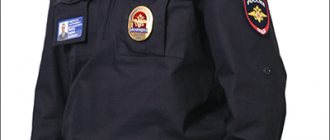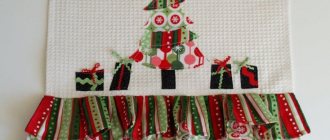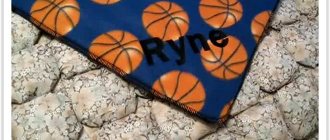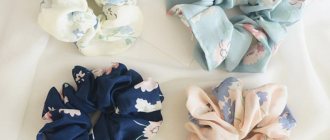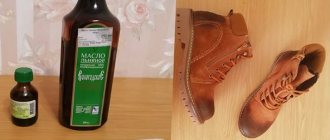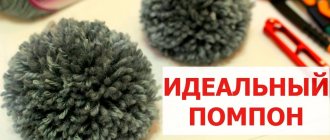Applique is always a fashionable and easy-to-make element of clothing, suitable for both children's outfits and adults.
At the same time, the options for decorating clothes with applique are almost endless: you can buy ready-made decorative elements, you can make them yourself and sew them onto a wardrobe item.
The appliqué has not only a decorative, but also a practical purpose; for example, it is often used to cover a stain or a frayed area, or some kind of fabric defect. Our master class will help you create your own applique that will decorate a child's dress.
Description of the application creation process
When assembling an applique for children, the basic component of the work will be fabric; it is applied to a special base of the following types:
- Cardboard.
- Plastic.
- Plywood.
- Cloth.
From small scraps, parents can cut out the necessary parts, which the child will subsequently attach using one of the common methods.
- Hand stitching is quite popular, because for such manipulations you do not need to have special equipment, you just need to get a needle and thread of a suitable shade.
- A sewing machine is also often used when creating crafts; this device can significantly reduce the time that will be spent in the process of making a picture or scene.
- The use of adhesive fabric with a lining will allow you to fix the elements on the base as firmly as possible; for this you will need a regular iron heated to a certain temperature.
Recommendation! There are ready-made images in art stores that can be used to decorate a child’s clothes by gluing them or to hide a stain on a favorite T-shirt. The process is quite exciting, so the work is worth doing together with young family members.
Connecting elements: sew or glue?
You can connect the application:
- Hand stitches in the form of loop, chain, satin stitches;
- using a machine (select stitch type (zigzag), pitch, height);
- Stygis fabric with a hot-melt adhesive layer. The use of threads, needles, and glue is not necessary. Children can do appliqué with the help of Stigis;
- gluing on film. You need to stock up on cling film and two pieces of foil. On an ironing board, assemble a multilayer sandwich of foil (the size is larger than the motif that is glued), the base face up, cling film (cut along the contour of the motif so that there is a margin of 5 cm). Iron at minimum temperature, leaving to cool. The method is ideal for working with cotton fabrics. The finished item can be hand washed, excluding twisting.
All types of applications
When choosing a template, you need to be guided by personal taste; bright and unusual designs have proven themselves well; you should pay attention to them first.
- There are several generally accepted types of crafts, among which there is a simple approach to performing the process.
- Before starting work, you need to select a sketch, after which the pattern is transferred to the clothing or base, but do not forget about the allowance, it is needed for further manipulations related to attaching the element.
- During assembly, hand or machine stitching is often used; when choosing a gluing method, special attention is paid to the structure of the fabric; the workpieces should not crumble when heated. Otherwise, the appearance will deteriorate, and all efforts will not bring the expected result.
Varieties
The fabric applique represents:
- Subject. The application is represented by separate elements assembled into one whole. Can be in the form of a leaf, branch, bird, etc.
- Plot. This application is compiled in such a way that the totality of actions and the sequence of events can be clearly traced.
- Decorative. Various patterns and ornaments are placed on the fabric. In this way you can decorate pillows, blankets, bedspreads, and other interior items.
By technique:
- Multilayer. The application is made of several layers superimposed on each other.
- Volumetric. A piece of padding polyester or cotton wool is placed under it, making the applique appear convex. This type of work requires careful washing, otherwise the applique will lose its appearance.
- Negotiable. The decorative blank is fixed from the inside out, not from the outside.
Double layer crafts
To learn how to make this type of product with your own hands, you need to start getting acquainted with easier options; the process of creating a composition is a little more complicated.
Two identical patterns are sewn together, and after the work is completed, the toy for children or interior decoration is turned inside out. To give the product a shape, it is filled with filler; the following are perfect for implementing such solutions:
- Cotton wool.
- Sintepon.
- Small foam.
As soon as the appearance suits the master who took up the process, the decorative part can be attached to the base or clothing. Using this technique, you can create a wide variety of paintings or scenes.
Reversible type
Before working on a beautiful applique, you will need to practice, because the technique is considered complicated. Before starting to implement your plan, experienced craftsmen recommend taking several pieces of fabric and working with them, and then moving on to the process of decorating the decorative elements.
The selected pattern or image is sewn onto the wrong side of a thick sweater, T-shirt, pillow, blanket or kitchen utensil; it is advisable to choose a blank in a contrasting color.
After which the upper part of the item is removed using sharp scissors; the process will require maximum care.
It is necessary to cut the fibers until the image from the inside becomes completely visible, after which the edges must be processed so that the item does not unravel and looks finished.
Important! The technique is quite complicated, so there is definitely no need to rush; to remove the top layer, it is better to take nail scissors with sharp ends.
Suitable materials for the job
When creating an applique, any fabrics and elements can be used in the form of:
- thick wool, tweed, wool blend. Smooth appliqués on items such as sweaters, jackets, skirts, vests, and coats can be made well from these materials.
- soft knitted. They will help in creating unexpected draperies and add volume.
- smooth thin ones such as cotton, linen, silk. They will serve as excellent materials to create an accent color or a background for smaller details.
- transparent such as tulle, organza, gas silk, lace, guipure in order to create voluminous details represented by frills, flounces, bows.
Recommendations from experts
When assembling paintings or scenes that will participate in exhibitions, you can avoid noticeable seams on the workpieces. To do this, experienced craftsmen often use a hot glue gun; thanks to such a practical tool, they can create neat and attractive crafts.
But when working with children, you need to follow safety precautions; it is better not to let your child touch the metal parts of the device.
Among the most suitable fabrics it is worth highlighting:
- Felt.
- Cotton.
- Wool.
- Leather.
When performing manipulations, it will not be superfluous to pay attention to the advice of experts, because people with experience can share useful skills and real-life cases that will help to avoid mistakes.
If the craft contains many small components, before major fixation they should first be distributed on the base and pinned with pins, evaluate the appearance or make adjustments.
To make the seams less noticeable, you can purchase the thinnest needles and buy cotton threads, then the masterpiece will be worthy of prizes at the exhibition. The allowance is very important; if you forget to leave it, then some problems will arise with fastening.
Decor with hot glue
To make the work look neat, you need to do everything right. An application with an adhesive base is placed on the product laid out on an ironing board, and then the following manipulations are performed sequentially:
- Turn on the iron and set the regulator to medium temperature.
- When it warms up, you can start gluing. Do not forget to put gauze on the applique so that the hot sole of the iron does not damage it.
- Wait for the base to melt. Fixing will take time (about a minute), the decor must be glued so that it does not come off the fabric when worn or washed.
If you do everything as described above, no problems will arise during the operation of the product.


